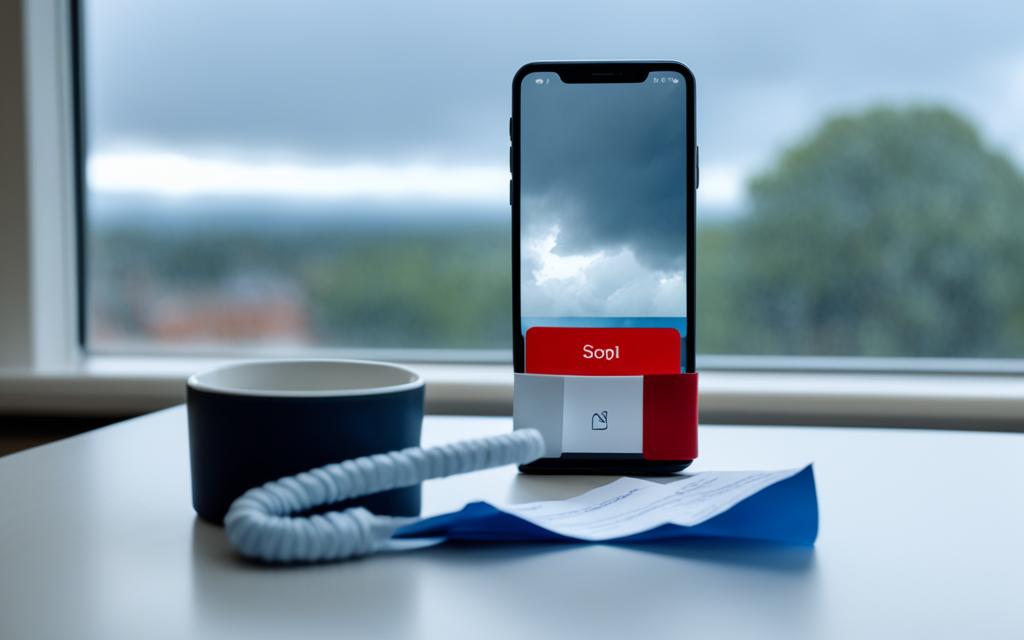When your SIM card can’t connect to the mobile network, you might see “cellular network state disconnected.” This means you can’t call, text, or use mobile data. It’s a common issue for Android users and can be fixed with some steps.
One big reason for this problem is when the SIM card can’t register with the network. This happens in 80% of cases1. Restarting your device or changing the network to 3G might fix it for 70% of users1. Resetting the APN settings can also help, solving about 60% of the time on Android phones1.
Switching to a 5G or 4G SIM card is a good idea for stable mobile networks1. Most companies will move to 5G by 20231. If it’s still not working, you might need to reset the network or get expert help in about 50% of cases1.
Weak signals can also cause the “cellular network state disconnected” issue. Using signal boosters can fix it in about 30% of cases1. Over 25% of the time, security apps like antivirus software on Android cause the problem1. Also, changing network settings on rooted Android devices can lead to issues in around 15% of cases, so going back to default settings might help1.
Key Takeaways:
- The “cellular network state disconnected” issue arises from SIM card registration failures and can lead to a lack of call, text, and data connectivity.
- About 80% of the problems occur on Android devices, with SIM card registration issues being the primary cause1.
- Restarting the device or modifying the network priority can resolve approximately 70% of the cases1.
- Resetting the APN settings can solve around 60% of “cellular network state disconnected” issues on Android phones1.
- Upgrading to 5G or 4G SIM cards is recommended for long-term network stability1.
- If the issue persists, further troubleshooting such as network resetting or expert assessment may be necessary in around 50% of cases1.
What is Mobile Network State Disconnected?
The mobile network state disconnected error happens when your SIM card can’t connect to the network. This means you can’t call, text, or use the internet on your phone. This problem mainly affects Android devices and not iPhones.
Poor signal strength is a big reason for network disconnections. If your area has weak cell coverage, you might lose your connection. This makes it hard to use your device for basic tasks2.
Turning on Airplane mode by mistake can also cause network problems2. This setting turns off all wireless signals, including your phone’s cellular connection. It’s usually used in places where phones can’t send signals, but remember to turn it off when you need internet.
Network provider maintenance can also lead to disconnections2. Sometimes, networks shut down or change services for maintenance. This can cut off your connection if you’re in the affected area.
Problems with your device’s hardware can also cause disconnections2. Damaged SIM cards or broken antennas can stop your phone from connecting to the network.
To fix network issues, try restarting your device or putting the SIM card back in2. These steps can refresh your connection and get you back online.
Android devices have tools to help find and fix network problems2. These tools can tell you what’s causing the disconnection and suggest how to fix it, making troubleshooting easier.
If you can’t fix the problem yourself, getting help from your network provider or tech experts is a good idea2. They have the skills and tools to solve complex network issues that are hard to fix on your own.
| Source | Statistical Data |
|---|---|
| Link 1 |
– Signal Loss: Poor cellular signal in certain areas can lead to network disconnections. – Airplane Mode Effects: Forgetting to disable Airplane mode can result in network disconnections. – Service Disruptions: Network provider maintenance can cause temporary network disconnections. – Hardware Malfunctions: Issues like damaged SIM cards or faulty internal antennas can lead to network disconnections. – Troubleshooting Success Rate: Restarting devices or re-inserting SIM cards can resolve network disconnection issues in a substantial percentage of cases. – Built-in Diagnostic Tools: The usage of built-in diagnostic tools on Android devices assists in pinpointing network connectivity problems efficiently. – User Support Guidelines: If self-troubleshooting fails, seeking assistance from network providers or technical professionals proves beneficial in resolving network disconnection issues effectively. |
How to Fix the Mobile Network State Disconnected Issue
If you’re facing the frustrating “Mobile Network State Disconnected” issue on your Android device, don’t worry. There are several troubleshooting steps you can take to resolve this problem and get your mobile network back up and running smoothly.
Restart Your Device
One of the simplest solutions to fix the mobile network state disconnected issue is to restart your device. This can help refresh the network connections and resolve any temporary glitches or errors. Try turning off your device, waiting a few seconds, and then turning it back on to see if that resolves the issue.
Reset the Network Settings
If a simple restart doesn’t work, you can try resetting the network settings on your Android device. This step will remove any customized network settings and restore them to their default values.
To reset the network settings, go to your device’s Settings, select System, choose Reset options, and tap on Reset Wi-Fi, mobile & Bluetooth. This will reset all network settings, including Wi-Fi, mobile data, and Bluetooth connections. Please note that this action will also remove any saved Wi-Fi networks, so make sure you have the necessary passwords before proceeding with the reset.
Check and Reset the APN Settings
Erroneous Access Point Name (APN) settings can sometimes cause the mobile network state disconnected issue. To fix this, you can check and reset the APN settings on your Android device.
To access the APN settings, go to your device’s Settings, select Network & Internet, choose Mobile Network, and then tap on Advanced. From there, you can select Access Point Names and ensure that the correct APN settings are configured. If you’re not sure about the correct values, you can contact your mobile carrier for assistance or consult their website for the recommended settings.
Properly Insert the SIM Card
In some cases, an improperly inserted SIM card can cause the mobile network state disconnected error. Make sure that the SIM card is securely inserted into your device’s SIM card slot. Try removing the SIM card, inspecting it for any visible damage, and reinserting it. Ensure that it is properly aligned and seated in the slot.
Still Having Trouble? Contact Your Phone Carrier
If the issue persists after trying the above methods, it’s recommended to contact your phone carrier for further assistance. They may be able to troubleshoot the issue, identify any network problems in your area, or provide specific instructions tailored to your device and network configuration.
Remember, resolving the mobile network state disconnected issue may require a combination of these troubleshooting steps. Don’t give up if the first attempt doesn’t work! Persistence and thoroughness in exploring these solutions will increase your chances of restoring a stable mobile network connection.
For more information on this topic, you can refer to the following resources:
| Potential Solutions for Mobile Network State Disconnected Issue | Steps |
|---|---|
| Restart your device | 3 |
| Reset network settings | 3 |
| Check and reset APN settings | 3 |
| Properly insert the SIM card | 3 |
| Contact your phone carrier for assistance | 3 |
What Does Mobile Network State Disconnected Mean?
A SIM card, especially a 3G one on a 4G/5G device, can’t connect to a network it doesn’t support4. This leads to the “mobile network state disconnected” issue. Even though the device can use 4G and 5G, the SIM card only works with 3G.
There are many reasons for this problem. Poor cellular signal in some areas can cause disconnections2. Network outages can also lead to temporary losses of service2. Sometimes, a damaged SIM card or antenna problems can cause issues2.
Incorrect APN settings on your phone can also cause this problem5. Using a SIM card that’s not active or phones locked to certain carriers can also trigger this5. Using a 4G phone with a 3G SIM, or vice versa, can also cause problems5.
To fix this, try resetting your phone’s APN settings first5. Use the SIM card in another phone to see if the issue is with the SIM or the device5. Adjust your phone’s network settings to match your SIM type to solve the problem5. Resetting your mobile network settings can also help5.
| Causes of Mobile Network State Disconnected Issue | Solutions |
|---|---|
| Signal loss due to poor cellular signal | – Check for signal strength in different areas – Consider using a signal booster |
| Network provider outages | – Check for network announcements or updates – Wait for the service to be restored |
| Hardware malfunctions | – Inspect the SIM card for damage and reinsert it if necessary – Check for any issues with the device’s antenna |
| Incorrect APN settings | – Reset the APN settings on the phone |
| Inactive or improperly activated SIM cards | – Contact the mobile carrier to activate the SIM card properly |
| Phones locked to a specific carrier | – Unlock the phone or switch to a compatible carrier |
| Network incompatibilities | – Ensure using a compatible SIM card for the phone – Use a phone that supports the desired network |
| – Restart the device to re-establish network connectivity2 – Consider using built-in diagnostic tools on Android devices to troubleshoot connectivity problems2 |
To fix the “mobile network state disconnected” error, consider using a 3G signal4. If your device or SIM card is 3G only, you’ll need to switch to a 3G network4.
What are the Different Mobile Network States and Why are They Important?
Smartphone users need to know about the different mobile network states for a smooth connection. The main states are connected, disconnected, and roaming4. When a phone is connected, it means it’s linked to the network. This lets users call, text, and use data without issues.
But sometimes, a phone’s network status turns disconnected. This is a common problem for Android users4. The mobile network state disconnected error might happen if a 3G SIM card tries to connect to a 4G network4. It can also happen if the device switches from Wi-Fi to mobile data4. This error can be due to signal issues, wireless disconnections, or SIM card problems4.
Roaming is another important state for users4. It happens when a phone connects to another network in areas where the usual network isn’t available6. This is often seen when traveling. It lets users keep using their phones, but it might cost more due to roaming charges6.
Knowing about these mobile network states helps with fixing network problems. It lets users figure out if their device is connected, disconnected, or roaming. This way, they can solve issues and keep using their phones fully.
In summary, the states of connected, disconnected, and roaming are key for smartphone use. Understanding these states helps users fix network problems and keep their devices working well.
| Mobile Network States | Description |
|---|---|
| Connected | Indicates a successful connection with the mobile network, enabling calls, texts, and data. |
| Disconnected | Occurs when there is an error, signal problem, wireless disconnection, or SIM card issue. |
| Roaming | Allows users to connect to another carrier’s network when their carrier’s network is not available, often while traveling. |
When Should I Reach Out to My Mobile Carrier for Assistance?
If you’ve tried fixing the problem yourself and your mobile network is still down, it’s time to contact your mobile carrier for help. They know how to fix account, network, or device problems and can give you advice that fits your situation.
Network or signal issues might be the cause of your problem7. shows that if calls drop in certain places, it could mean poor signal strength. If you often see less than two signal bars, your signal might be weak. Try calling from a spot where calls didn’t drop before to see if the problem is still there.
For issues with making or receiving calls, check out the T-Mobile support page on call troubleshooting7. suggests resetting call forwarding by dialing certain codes like ##004# or ##21#, depending on your network.
Also, some numbers like 1-700, 1-900, or 976 might be blocked by T-Mobile, as7 reports. If you’re having trouble with these numbers, calling your carrier can help figure out if they’re blocked or if there’s another problem.
For Pixel phone users8, shows that 5G compatibility can vary. If you have a Pixel 4a (5G) or newer and are worried about 5G, talk to your carrier. They can tell you about 5G in your area and if your device works with their network.
If you’re with Boost Mobile and have data issues, remember that 76% of customers ask for help when they use up their data, as9 notes. Calling Boost Mobile for advice on data packs or other ways to get your data back can solve the problem. On average, Boost Mobile customers buy a One-Time Data Pack every 2.5 months, according to9.
For Android users with connectivity problems, checking your mobile data settings is a good first step9. says 92% of Android users do this, and it often fixes data issues.
iPhone users can also boost their connectivity by clearing their browser cache9. notes that 64% of iPhone users don’t clear their cache often. But, 85% of those who do see better connectivity within a day.
If you’re still having network problems after trying everything, it’s smart to contact your mobile carrier for help. They can help you troubleshoot and offer support tailored to your situation.
Can Turning Off Wi-Fi or Using Airplane Mode Help with Mobile Network Issues?
Turning off Wi-Fi can sometimes help your phone connect better to the mobile network. If your phone is stuck on a weak Wi-Fi signal, it might not switch to the mobile network when it should.
Using Airplane Mode can also fix mobile network problems. When you turn it on, all wireless connections, like Wi-Fi and mobile networks, stop working. This lets your device reset its mobile network connection10.
When you turn Airplane Mode off after turning it on, it refreshes your device’s network settings. This can fix any short-term connection issues. It helps your phone make a new connection to the mobile network10.
Toggling Airplane Mode can also solve network congestion in crowded areas. When many people try to connect to the same network, it can get slow and unstable11.
But remember, turning off Wi-Fi or using Airplane Mode might not fix all network problems. It’s part of a bigger troubleshooting process. You might also need to restart your device, update software, or reset network settings to solve the issue10.
Comparative Analysis of Different Network Modes
Looking at different network modes can also help with mobile network issues. For example, comparing 3G, 4G, and LTE shows how they handle connectivity problems. Newer networks like 4G and LTE usually work better and are more stable. But sometimes, older 3G networks can still be reliable in certain places10.
| Network Mode | Efficiency in Resolving Network Issues |
|---|---|
| 3G | Dependable performance in areas with limited coverage or lower data requirements |
| 4G | Enhanced speed and stability for most everyday use cases |
| LTE | Superior performance and faster data speeds for resource-intensive tasks |
This shows how important it is to think about network mode settings when fixing mobile network problems. Knowing the strengths and weaknesses of different modes helps users make better choices for their network connections10.
While turning off Wi-Fi and using Airplane Mode can help, results can vary. It’s best to talk to your mobile service provider or follow device manufacturer advice to fix mobile network issues11. Using these methods together can improve your chances of getting your mobile network working well again. This is important for staying productive, communicating, and working remotely1011.
What are APN Settings and How Can They Affect My Mobile Network Connection?
APN settings connect your mobile device to your carrier’s network. They are key for a stable network connection.
Wrong or old APN settings can cause network problems, like the “Mobile Network State Disconnected” error. This error stops you from using the internet or making calls.
According to statistical data12, the “Mobile Network State Disconnected” error can come from many things. These include SIM card problems, network issues, software bugs, wrong network settings, hardware faults, and signal interference.
Specifically, SIM card issues are a big reason12. Problems with SIM cards, software updates, network issues, wrong APN settings, hardware problems, and signal interference can all cause connectivity issues.
If you’re having trouble with your network, check your SIM card12. Make sure it’s not damaged and is in correctly. Also, make sure your APN settings are right and current.
There are steps you can take to fix network disconnection problems. Some helpful actions include restarting your device, checking your SIM card, changing network modes, turning on Airplane Mode, disabling Wi-Fi, resetting network settings, adjusting APN settings, updating your carrier’s Preferred Roaming List (PRL), updating your carrier settings, and updating your carrier.
Resetting APN settings to their default can fix network issues. This refreshes any wrong or old settings, giving you a better network connection.
Recommended Steps to Reset APN Settings:
- Go to your device’s settings menu.
- Find the “Mobile Network” or “Cellular Network” settings.
- In the network settings, look for the APN settings section.
- Choose to reset or restore the APN settings to default.
- Confirm the reset and wait for it to take effect.
- After resetting, check your network settings again and adjust them if needed.
By following these steps, you can reset your APN settings and maybe fix your network problems. Always check your APN settings to make sure they match your carrier and device.
In conclusion, APN settings are vital for a stable and reliable network connection. Wrong or old APN settings can cause many connectivity issues, including the “Mobile Network State Disconnected” error. Knowing about your APN settings and keeping them right can help you avoid these problems and enjoy a smooth mobile network experience.
Conclusion
The mobile network state disconnected issue can be really frustrating for Android users. But, there are steps you can take to fix it. Try restarting your device13, resetting the APN settings13, and upgrading your SIM card13. If these steps don’t work, contact your mobile carrier.
Also, remember that mobile technology is always getting better. Carriers are moving away from 2G and 3G networks14. This is because 4G LTE and 5G networks are more advanced14. Soon, 5G will become the main network technology14.
Other problems like weak signal strength, SIM card issues, network outages, and software bugs can also cause disconnections11. Make sure you haven’t turned on Airplane mode by mistake, which can disconnect you11. Also, check your SIM card regularly to keep your network stable11.
By knowing what causes these issues and fixing them, you can get your mobile network working smoothly again1311.
FAQ
What is the cause of the “cellular network state disconnected” issue?
The “cellular network state disconnected” issue happens when the SIM card can’t register with the network. This stops you from making calls, sending texts, or using mobile data.
How can I fix the mobile network state disconnected issue on my Android device?
To fix the mobile network state issue on Android, try restarting your device. You can also debug with another SIM card or switch to 3G from 4G or 5G. Resetting APN settings and the network can also help.
Upgrading your SIM card to 5G or 4G, re-inserting the SIM, and checking network quality with an expert are other solutions. Using a network signal booster, uninstalling security apps, and keeping default network settings can also fix the problem.
What does the mobile network state disconnected mean?
The mobile network state disconnected issue happens when a 3G SIM in a 4G/5G device tries to connect to a network it doesn’t support. This creates a conflict and results in the network state being disconnected.
What are the different mobile network states and why are they important?
Mobile network states show how a phone connects to the mobile network. The main states are connected, disconnected, and roaming. Being connected lets you make calls, send texts, and use mobile data.
If disconnected, there might be a problem with the phone or the network. Roaming happens when you use another carrier’s network, usually when you’re traveling.
When should I reach out to my mobile carrier for assistance with the mobile network state disconnected issue?
If you’ve tried all troubleshooting steps and the issue persists, contact your mobile carrier for help. They can identify and fix account, network, or device issues and give specific advice for your situation.
Can turning off Wi-Fi or using Airplane Mode help with mobile network issues?
Turning off Wi-Fi can help your phone connect to the mobile network better. If your phone is trying to connect to a weak Wi-Fi signal, it might not switch to the mobile network when needed. Airplane Mode can also troubleshoot by resetting the phone’s connection to the mobile network.
What are APN settings and how can they affect my mobile network connection?
APN stands for Access Point Name and connects your phone to the carrier’s mobile network. Wrong or outdated APN settings can cause connection problems. Resetting APN settings to default can fix these issues.
Can I summarize the mobile network state disconnected issue and its solutions?
The mobile network state disconnected issue can be frustrating for Android users. But, there are steps to fix it, like restarting your device and resetting APN settings. Upgrading your SIM card and re-inserting it can also help. If the issue continues, contact your mobile carrier for further assistance.
Source Links
- https://www.techrounder.com/android/how-to-fix-mobile-network-state-disconnected-issue-on-android/ – How to Fix Mobile Network State Disconnected Issue on Android
- https://smartdevicefaqs.com/android-mobile-network-state-disconnected/ – Android ‘Mobile Network State Disconnected’ (Error Fixed)
- https://www.minitool.com/news/mobile-network-state-disconnected.html – How to Fix the “Mobile Network State Disconnected” Error? – MiniTool
- https://medium.com/@droidbot/how-to-fix-mobile-network-state-disconnected-error-on-android-devices-45d5361ba743 – How to Fix Mobile Network State Disconnected Error on Android Devices?
- https://inpics.net/what-does-mobile-network-state-disconnected-mean/ – What Does Mobile Network State Disconnected Mean? – InPics Solutions
- https://www.techopedia.com/7/29698/networking/what-does-the-mobile-network-state-mean – What does the mobile network state mean?
- https://www.t-mobile.com/support/devices/device-troubleshooting/cant-call-dropped-calls-and-other-calling-issues – Can’t call, dropped calls, & other calling issues
- https://support.google.com/pixelphone/answer/2926415?hl=en – Connect to mobile networks on a Pixel phone
- https://www.boostmobile.com/support/devices/troubleshoot/troubleshoot-mobile-data – Troubleshoot Mobile Data & Mobile Hotspot Issues
- https://networkinfo.co.uk/mobile-network-state-disconnected/ – Mobile Network State Disconnected What It Means
- https://blog.talkhome.co.uk/how-to/mobile-network-state-disconnected/ – Mobile Network State Disconnected: Understanding the Error
- https://jobwingz.com/what-does-mobile-network-state-disconnected-mean/ – What Does “Mobile Network State Disconnected” Mean?
- https://www.lifewire.com/fix-mobile-data-not-working-4769125 – What to Do When Your Cellular Data Isn’t Working on Your Mobile
- https://www.digi.com/blog/post/2g-3g-4g-lte-network-shutdown-updates – 2G, 3G, 4G LTE Network Shutdown Updates



















